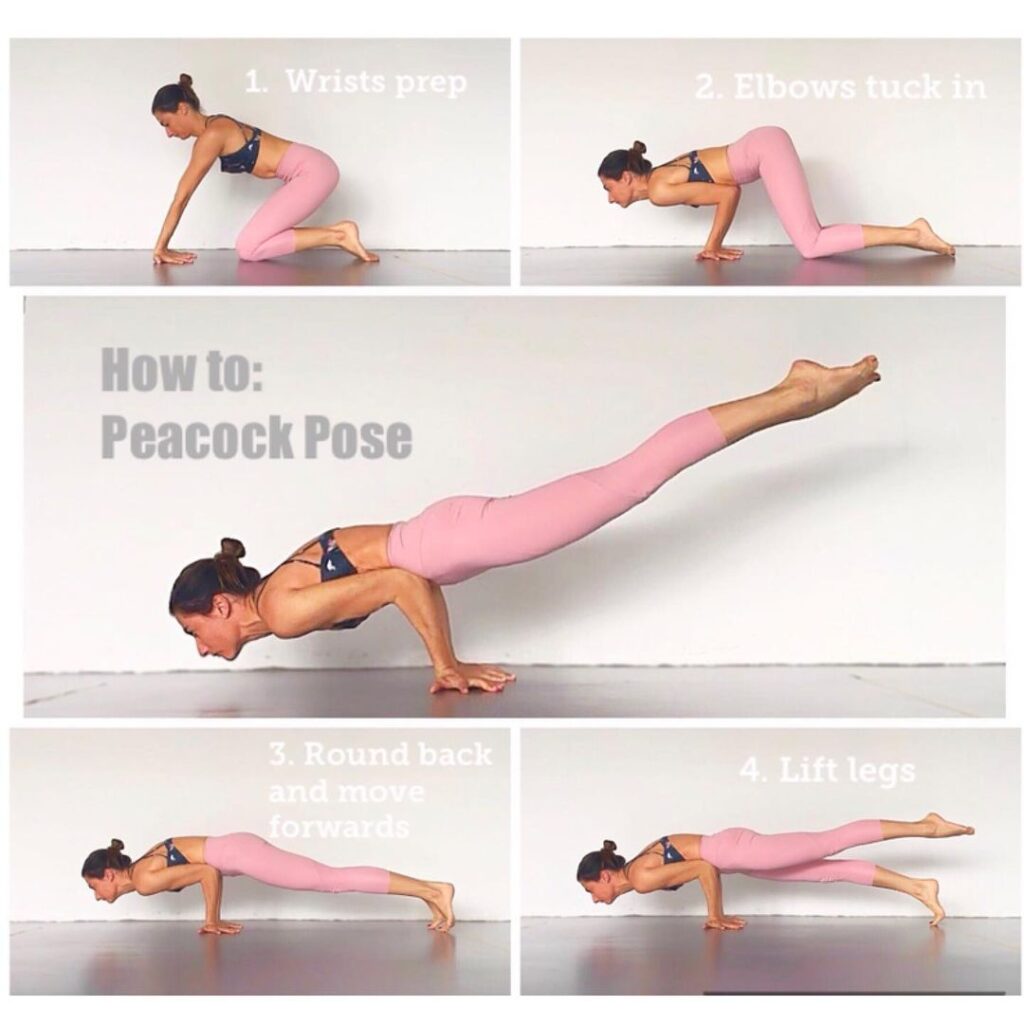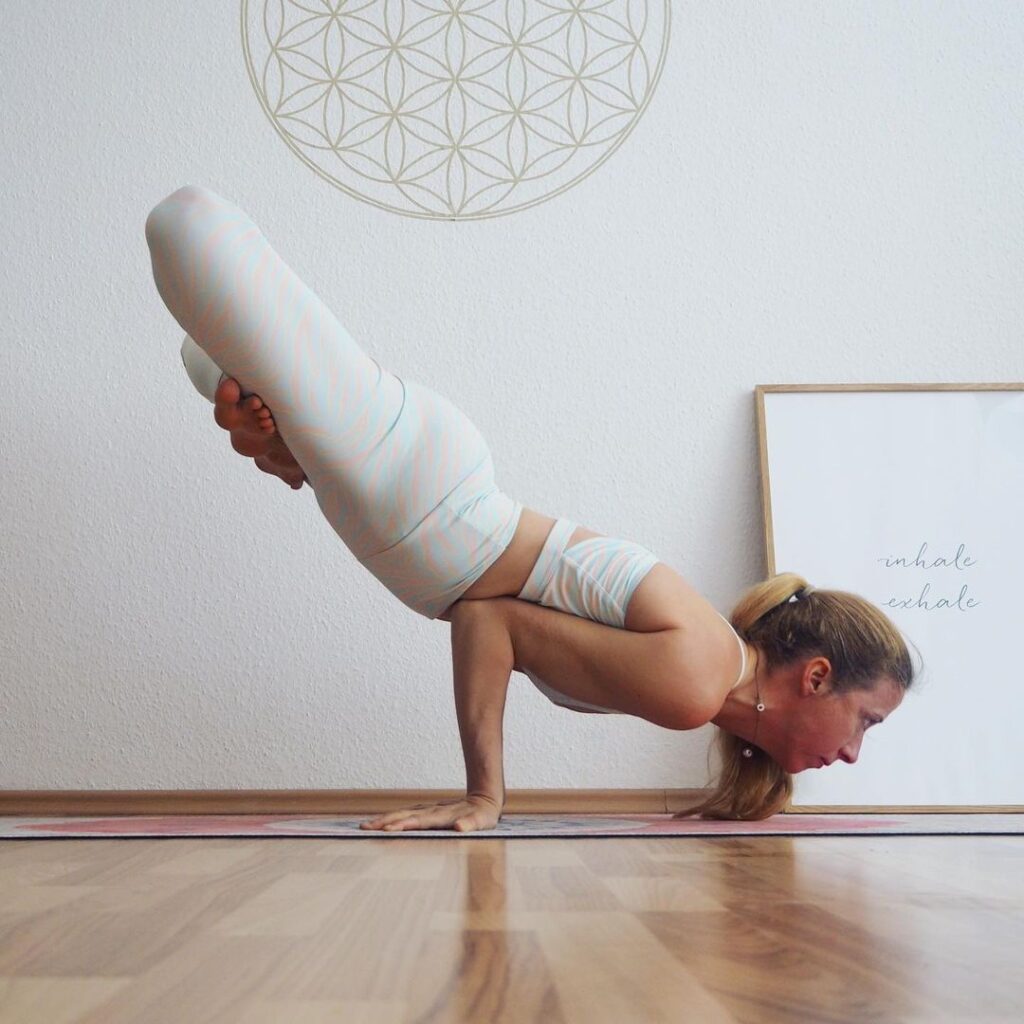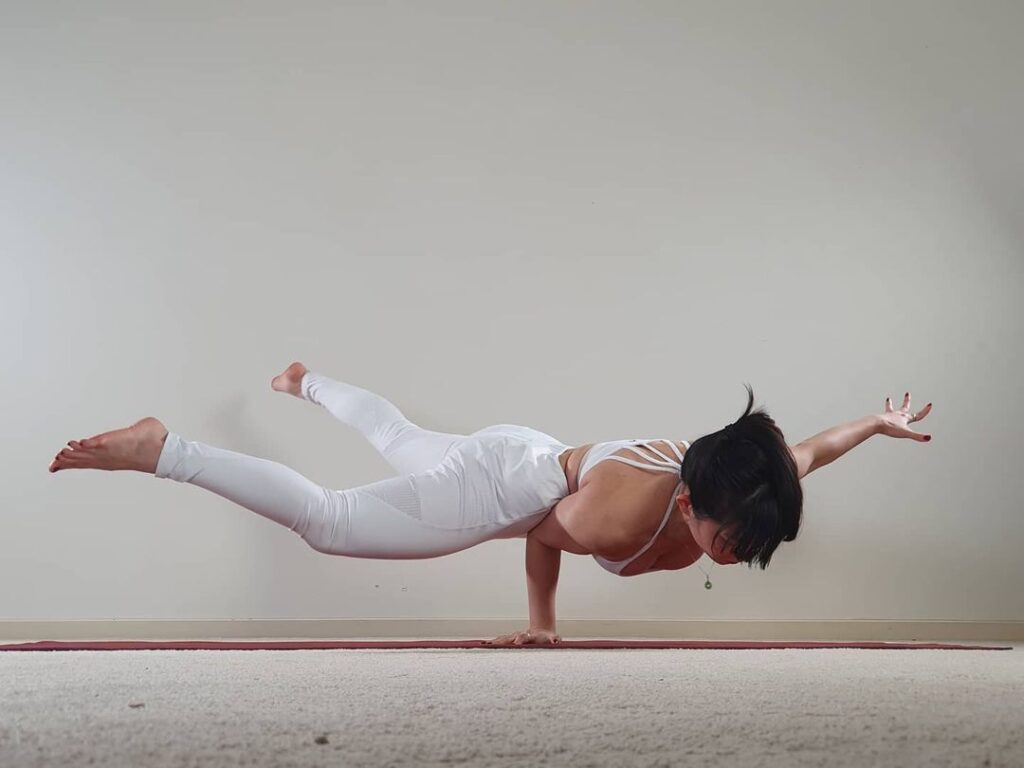Mayurasana, also known as Peacock Pose, builds strength in the forearms and wrists while simultaneously makes your back and your legs strong.
It is useful to perform the Mayurasana (Peacock Pose) prior to the Balasana (Child’s Pose) or the Adho Mukha Svanasana (Downward Facing Dog Pose).
Due to its advanced nature, this posture is best incorporated near the middle or end of a sequence of postures, such as the order of rows by Surya Namaskar or seated sequence yoga poses. Prepare for this advanced yoga pose by opening up by targeted body parts. The wrist is particularly prone to straining, so wrist stretch is encouraged.
Meaning
The Mayurasana derived from the Sanskrit name of the two words — Mayur + Asana:
- “Mayur” = “peacock”
- “Asana” = “pose or posture”
According to the Hindu texts, the Peacock is associated with Indra (God of Thunder and Rain) and symbolizes love and immortality. In this regard, Mayur is called Harbinger (the one who gives an advance signal for the arrival of rain) – by performing a dance to celebrate the arrival of rain.
Information
| Known as: | Mayurasana, Peacock Pose |
| Sanskrit name: | मयूरासन |
| IAST: | Mayūrāsana |
| Pronunciation: | my-yer-ahs-anna |
| Level: | Advanced |
| Type: | Arm Balance |
| Total time: | 10 plus seconds, depending on experience level |
| Drishti: | Tip of nose |
| Chakra: | Ajna Chakra |
| Focus: | Arms |
| Counterposes: | Child’s Pose (Balasana), Sphinx Pose (Salamba Bhujangasana), Downward-Facing Dog (Adho Mukha Svanasana), Corpse Pose (Savasana) |
| Preparatory poses: | Locust Pose, Four Limbed Staff Pose, Staff Pose, Cow Face Pose, Plank Pose, Forearm Plank Pose |
| Follow-up poses: | Downward Dog Pose, Child’s Pose, Shoulder Pressing Pose |
| Indications: | Kidneys, liver, intestines, pancreas, circulation, gall bladder |
| Contraindications: | Wrist injury, elbow injury, Carpal tunnel syndrome, Migraine, Low or high blood pressure |
Benefits of Peacock Pose
Peacock Pose is a challenging arm balancing pose where the wrist is pulled upward to keep the body in balance and comes with the following many physical and mental benefits:
- Physical Benefits:
- Tones the abdominal muscles
- Strengthens the wrists, forearms, and elbows
- Lengthens the spine
- Cultivates balance and poise
- Stimulates digestion
- Improves circulation to the intestines, colon, stomach, spleen, kidneys, and liver
- Mental Benefits:
- Develops focus
- Improves concentration
Step-by-step Mayurasana

- Begin on your hands and knees with the fingers facing back toward the knees and the little fingers touching.
- Bend the elbows, keep the hands together, and lean forward to rest your abdomen on your elbows and your chest on your upper arms. Bring the elbows as low as possible on your abdomen. Begin to support more body weight on the hands. Women may separate their upper arms more to leave space and not compress the breasts.
- Straighten the legs and bring the weight forward to balance on the arms and hands. Spread the toes to help engage the legs and create lift. Engage the legs fully, lifting from the inner thighs. Keep the muscles of your torso fully engaged.
- Stay in this posture for 10 seconds at first. You may stay 10+ seconds, depending on your experience level. Over time, you will be able to increase your time in this yoga pose, as you increase in your strength.
Common mistakes
Mayurasana, like many advanced yoga poses, can be challenging to master and requires a lot of practice and patience. Here are some common mistakes that you can make while practicing this pose, and how to avoid them:
- Placing the hands too far apart: One of the most common mistakes in this pose is placing the hands too far apart. This can lead to instability and make it difficult to balance in the pose. To avoid this mistake, place your hands shoulder-width apart, with your fingers facing your body.
- Collapsing the elbows: When attempting this pose, many people have a tendency to let their elbows splay out to the sides. This can put undue strain on the shoulders and make it difficult to lift the legs off the ground. To avoid this mistake, keep your elbows close to your body and engage your triceps to lift your body up.
- Forgetting to engage the core: This yoga pose requires a lot of core strength to maintain balance and control in the pose. Forgetting to engage your core can lead to wobbling and instability. To avoid this mistake, engage your core muscles by drawing your navel towards your spine and lifting your lower abs up and in.
- Not breathing deeply: In any yoga pose, it’s important to remember to breathe deeply and evenly. Holding your breath or breathing shallowly can cause tension in the body and make it difficult to stay in the pose for an extended period of time. To avoid this mistake, take deep, slow breaths and focus on maintaining a steady rhythm.
Props and Modifications of Peacock Pose
To make Mayurasana easier for beginners, a modified version of the pose can always be used by using props. Here are some ways to use props to modify this yoga pose:
- Peacock Pose may wrap a strap around your elbow, to avoid stretching of the elbow in the final position of the posture. This further strengthens the foundation of the posture.
- In case of difficulty in keeping the feet up during the last pose, you may resort to a chair under your feet. You can also seek the help of a partner to find balance in the posture.
- You can place yoga blocks under your palms. This slightly increases the posture, which keeps it in balance for a longer period of time.
Variations
Lotus Peacock Pose and Wounded Peacock Pose are the advanced variation of Peacock Pose. Individuals who wish to elevate the level of challenge in their practice may undergo the following changes:
Lotus Peacock Pose (Padma Mayurasana)

- In the Peacock Pose, the feet remain straight and are flexible with the toes pointing in the direction of the back. Whereas in Lotus Peacock Pose, the legs are fastened to the Lotus Pose and supported by core muscles with glutes and thigh engagement.
- In this pose, the legs are folded to form the Lotus Pose. The weight of the entire body is supported on the hands, while the core muscles and lower thighs are supporting the bent legs in the Lotus Pose.
Wounded Peacock Pose (Pungu Mayurasana)

- Here, the body is supported by either hand, whose elbow rests next to the navel area. The core muscles keep the legs straight and balanced and the other hand is in the air. Whereas, in Peacock Pose, the legs remain straight and the elbows are placed against the core muscles.
- Wounded Peacock Pose is another variation for Peacock Pose.Here, the body is resting on one arm, where the elbow rests next to the naval area. The legs should be straight and the other hand should be in the air in the forward direction.
Contraindications
Since Peacock Pose is an advance level arm balance yoga posture, the following of these contraindications should be kept in mind during practice:
- Individuals suffering from injuries to the wrist, elbow, shoulder, hips, lower back, neck, or rib cage should avoid the practice of this yoga pose.
- Individuals with back pain, surgery anywhere, seniors with arthritis, heart related issues, blood pressure, menstruating women, pregnant women, issues related to abdominal organs, etc., should avoid practicing of yoga asana.
- Anyone with weak bones or body structure, weak digestive system, individuals who still do not know about their body and breath, or suffering from carpal tunnel syndrome, should avoid the practice of this yoga pose.
- Any effort with Peacock Pose should be made under the guidance of a yoga teacher/instructor under such circumstances.















